
Sander de Vries & Corné Dubelaar
Sports, Media Technology & Distribution
2 Dec 2024, 10 min
SportsPro Madrid 2024: Everyone is still coming to terms with technology and the monetization of their content

SportsPro Madrid 2024 brought together over 1,000 sports industry leaders, providing a platform to explore the opportunities and challenges shaping the future of sports media and broadcasting.
Among the many insights shared, one core challenge stood out and was powerfully summarized by Wim Swildens, the CEO of Kiswe.
Wim Swildens, CEO of Kiswe
At Hypersolid, we are fully equipped to create business impact for our sports partners at various levels, which we have already proven as digital partners with premium sports brands like ESPN, Max Verstappen, Ajax, and the KNVB.
In our discussions with several rights holders, broadcast partners, and clubs and the various presentations and showcases we attended at SportsPro Madrid, we came to 5 key takeaways.
01 Rights holders are looking for a solution for digital fragmentation
Several talks focused on a topic that traditional rights holders have struggled with for the past few years. How do you keep the value of your media rights for traditional broadcasting on the same level or higher when so many people are using other platforms like TikTok and Instagram to consume content?
The modus operandi for the past years for organizations like the IOC or UEFA has been setting up a restrictive partnership with platforms like TikTok, which gave minimal access to posting official content or posting from official venues. This same restrictive policy was used for other stakeholders like the players and athletes.
UEFA slightly altered that approach for 2024 by agreeing to a partnership with TikTok, giving TikTok and its users more access to official event content. This partnership gave some valuable insights into the amplification power of TikTok as a platform.
Rollo Goldstaub, Global Head of Sports Partnerships at TikTok indicated that around the UEFA 2024 European Championship, there was an engagement of 8.4 billion on TikTok. The breakdown of that engagement is where it gets interesting: around 1% was created by Official Broadcasters, 10% by Athletes, and the remaining 89% came from user-generated (co-created) content.
However, rights holders are still looking for ways to convert this engagement better, as they see it as their obligation to divert the new audiences on TikTok back to the official content of their media rights holders.
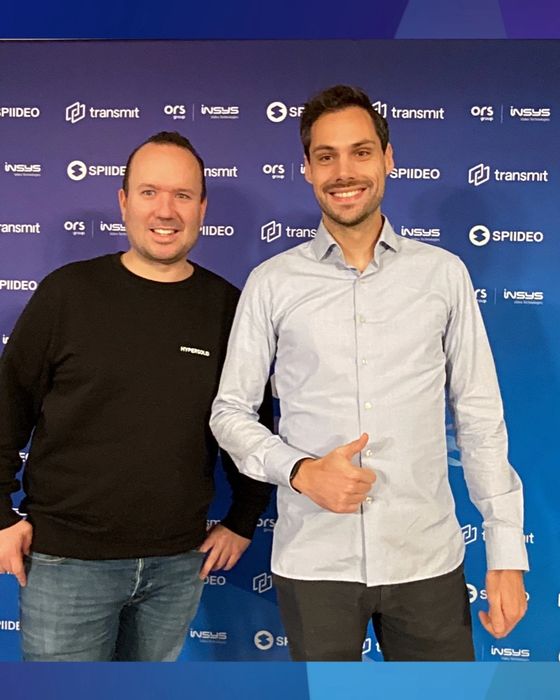
Stepping into SportsPro Madrid
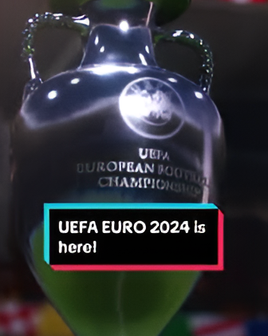
UEFA tweaked its 2024 strategy, partnering with TikTok
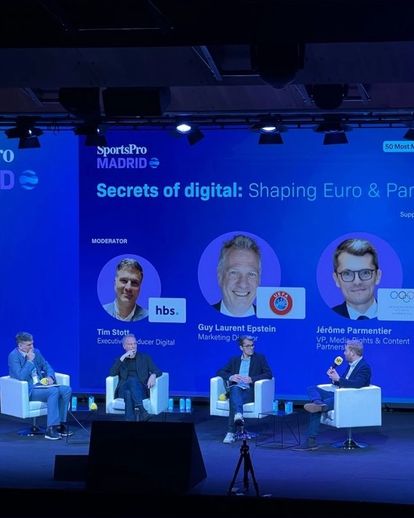
Rollo Goldstaub (right) on UEFA 2024 fan engagement
02 Content: the fight to stay relevant
Almost all the speakers at the conference were signaling the same issue. Because of the enormous amount of content and the fragmented media consumption nowadays, it has become a battle to stay relevant as a brand. All were trying to find an effective way to deal with the large amount of touch points for their brand.
The answer to this issue needed to be more clear-cut. Everyone wanted to be present on as many platforms as possible and serve content suited to that platform. This approach primarily resulted in high content creation costs that were difficult to explain to the other stakeholders within their organization as that presence needed to be more monetizable. A significant influence on this was that many sports organizations are still focused on reporting engagement numbers from the different (social) channels and need help showing how that engagement translates into consumer spending.
A second solution most of the sports organizations agreed upon was that the content created needed to be broader and less directly related to the athletes’ performance. There were several examples of this, a few of them worth mentioning.
Fueled by the shockingly low amount of access the media department of Tottenham Hotspur has to their players; they decided to set up training center arrival videos every morning. This resulted in the media team waiting by the gates of their training center, asking their players one non-football-related question upon their arrival.
Aided by better access to their riders, Moto GP created the series ‘Under the Skin’, where their riders talk about the scars from competing in Moto GP. These scars highlight the danger and risks involved with Moto GP and show the riders as the heroes that they are, which resonates very well with the Moto GP brand.
However, the best example of ‘out of the box’ content came from the NFL. They have been at the forefront of creating new fandom for their sport for years by using Beyond Sports, a former Triple venture now operating under Sony. This year we will see a second round of ‘Funday Football’ featuring the Simpsons.
The first installment saw the NFL using Beyond Sports’ unique technical capabilities to transform a live broadcast of an NFL game into a 3D live broadcast using Toy Story Characters playing that same game in a Toy Story environment. The Toy Story game was broadcast simultaneously with the ‘normal’ game on ESPN+ and Disney. It became the most watched live broadcast on those channels in history, reaching a much younger audience than the regular game. On top of the record viewership, it also received 3 Sports Emmys that year.
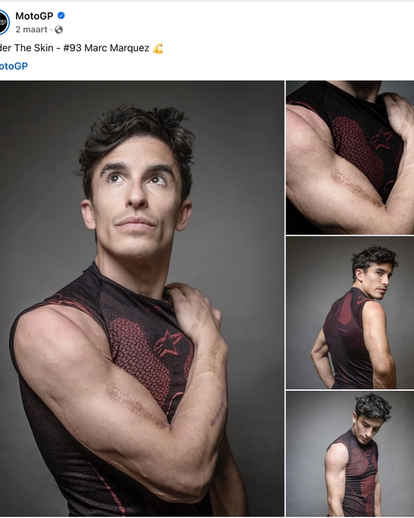
MotoGP's 'Under the Skin' series perfectly reflects its brand
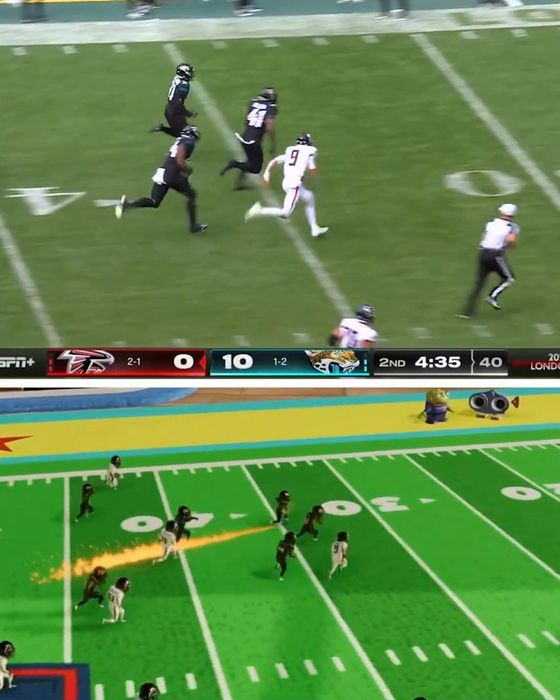
Three-time Emmy winner Beyond Sports crafts real-time virtual recreations of live sports events
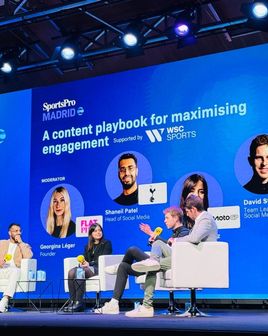
Spurs was named winner in the ‘Best Social Channel’ category
On December 9, Homer Simpson and the gang will appear during The Simpsons Funday Football, a real-time animated NFL Monday Night Football game on Disney+ and ESPN+.
This year’s animated game will take place in the Simpsons’ hometown of Springfield at the fictional Atoms Stadium, with Bart Simpson joining the Cincinnati Bengals on the field, and Homer siding with the Dallas Cowboys. Meanwhile, Marge and Lisa Simpson will interview players during the game, while other characters will appear throughout the telecast. To top it all off, animated versions of ESPN NFL commentators will be present during the game to match the traditional telecast.
03 Content creators as the drivers of value
Juventus presented a refreshing approach to content creation with their Juventus Creator Lab, which is inspired by the creator economy and infuses their learnings into football. Juventus believe that creators are the content heroes of this time. Creators are the ones driving growth, more than the Juventus brand or the club itself are possible to do. That’s why Juventus decided to put the creators in the driver’s seat for Juventus-related content.
Relying on creators instead of the players for the digital strategy also removes risks the club has encountered over the past few years. Marco Castellaneta from the club explained: ‘Three years ago, we had a combined reach of 600 million followers with our players, but when Ronaldo left the club, we were down to 250 million followers. Then players like Angel di Maria and Paul Pogba left and we were down to 40 million followers. As the media team, we can’t decide which players will come to our club, so we decided to take the matter into our own hands.’
The Juventus Creator lab decided to work closely with creators like Céline Dept, a Belgian soccer influencer making bespoke content for the Juventus Creator Lab.
This is crucial to stay relevant outside of sporting endeavors. As Juve stated: a model that works when you don’t win on the pitch will work even better when there are results.
Marco Castellaneta, Juventus Football Club
As part of this strategy, Juventus are also actively creating new projects and opportunities that can be branded by partners. By creating content as IP they also create lasting value as partners want to be present in these new projects, which in turn do not depend on the result of the team or the players at the club.
However, Castellaneta was also outspoken about their approach to commercial content: ‘Do not split fan engagement and commercial content. They need to merge. Commercial content always needs to be editorially ok. The current generation doesn’t accept advertising anymore. Sponsored content still needs to be credible. We build content plans based on categories and look at how we can naturally integrate partners.’
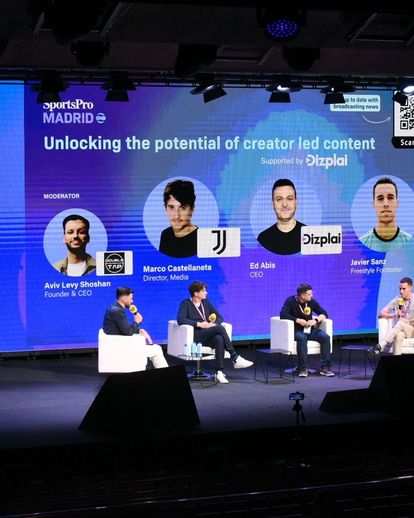
Marco Castellaneta on shifting focus to creators
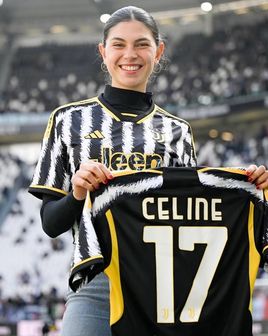
Juventus Creator Lab partners with soccer influencers like Céline Dept
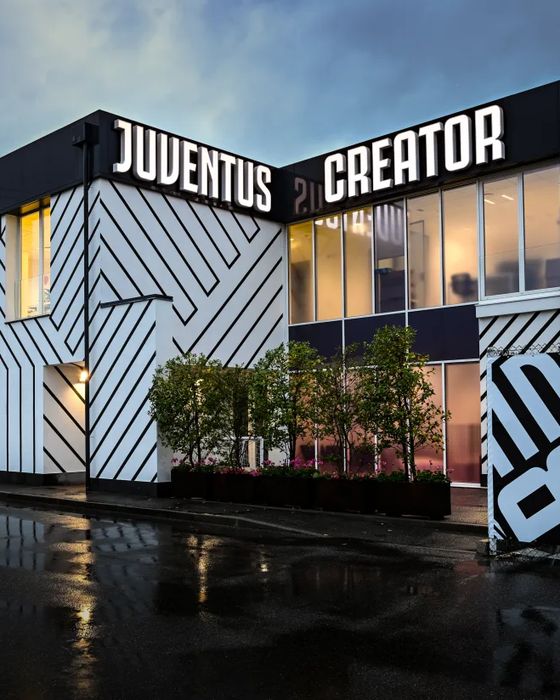
Drawing from the creator economy to innovate football
04 Tech is already adding value for rights holders if implemented well
The main takeaway from SportsPro 2025 was that there is still room for improvement in integrating Technology into Sports Media. Rights holders and organizations still need help adapting to a fragmented media landscape and, more importantly, turning engagement into actual revenue.
The key to revenue generation lies in creating your content platform. From a user experience point of view, this already makes sense. People in the sport or organization are usually best suited to create bespoke experiences as they are in the know. From the point of view of a rights holder, building your platform is even more critical, as it keeps you in control of how you show your brand.
From a business point of view creating your own platform works at various levels.
Firstly, your own platform allows you to monetize better content that is currently under-utilized. This works for rights that are not being sold in a particular region, but also for rights that only work on a larger scale. An interesting insight into this was shared by Wim Sweldens, CEO of Kiswe, who claimed that currently, rights holders only have a 30% penetration, leaving 70% of the potential untapped.
Although there will always be room for traditional media rights deals in strong markets, having your own platform also gives you stronger negotiation skills and the possibility to create hybrid models. In markets with good media rights deals in place, it’s not necessary to act. In other markets, an owned platform allows you to create hybrid deals or go full OTT, creating more business.
Secondly, an own platform also creates more value for the rights holders, as they can sell the platform they deliver as an add-on to the rights. This will result in more commercial opportunities while also giving the fans additional value by more and better access to the product.
This can work differently for various stakeholders. For Formula 1, giving users of a domestic TV broadcaster free access to the F1 app creates extra commercial value on top of the rights, at the same time it gives the fans a better Formula 1 experience. For a football club like Feyenoord, it creates the possibility of increasing the revenue from their audience, as the stadium is currently sold out for every match.
Thirdly, having their own platform gives rights holder’s crucial insight into the data of their user. This information is valuable for unlocking additional revenue streams like ticketing, merchandising and targeted advertising. Third-party platforms do not allow you to know and own your customers, which significantly limits the possibility of monetization.
05 There is no clear-cut solution; the key is to be flexible and constantly experimenting
The best way of working for rights holders with technology suppliers lies in a close-knit partnership between both.
An excellent example of how this can work came from a brutally honest insight Kay Dammholz from the DFB shared:
‘With streaming, we did not have an idea what we were doing, and to be honest, we still don’t from time to time. That’s why it’s important to have a partner who you can trust and guide you through challenges and not someone that gives you a menu card and lets you pick for yourself.’
Creating a successful platform largely depends on setting up a real partnership where your tech supplier guides you through all the possible solutions and proactively works with you. It also helps innovators to be bold within their organization.
Kay Dammholz, Deutscher Fußball-Bund
From a technical point of view, it is essential to create a flexible architecture as this gives you the right framework to experiment and learn as much as possible. An example DFB gave of this flexibility is including as many payment options as possible (AVOD, TVOD, SVOD, FREE) to cater to different business cases and different kinds of content. Turnkey and productized all-in-one solutions do not give you those options, limiting future solutions.
That’s also why Hypersolid believes that the future belongs to organizations with a composable tech stack, using best-of-breed solutions. This architecture gives maximum flexibility to organizations and gives them the power to stay agile while operating on a robust technical foundation. This approach significantly benefited our successful media, entertainment and sports partners.
As for distribution, there is a critical border to be crossed. Many platforms live on mobile devices, but much sports consumption is ideally suited for the big screen. Therefore, many organizations need to make their platforms available on Connected or CTV Apps, bringing their unique experience to the big screens.
The uptake of AI in designing the future of sports also leaves a lot of room for improvement. Many organizations are currently dealing with very high costs in content production because of the fragmented media landscape. AI could drastically reduce those costs if implemented well.
A second big opportunity for AI is using it to do predictive match analysis based on data. This could be offered as an extra service to the user when watching live sports but could also be a potential goldmine for betting organizations that wish to do more around live sports.
Contact us and let's get started.